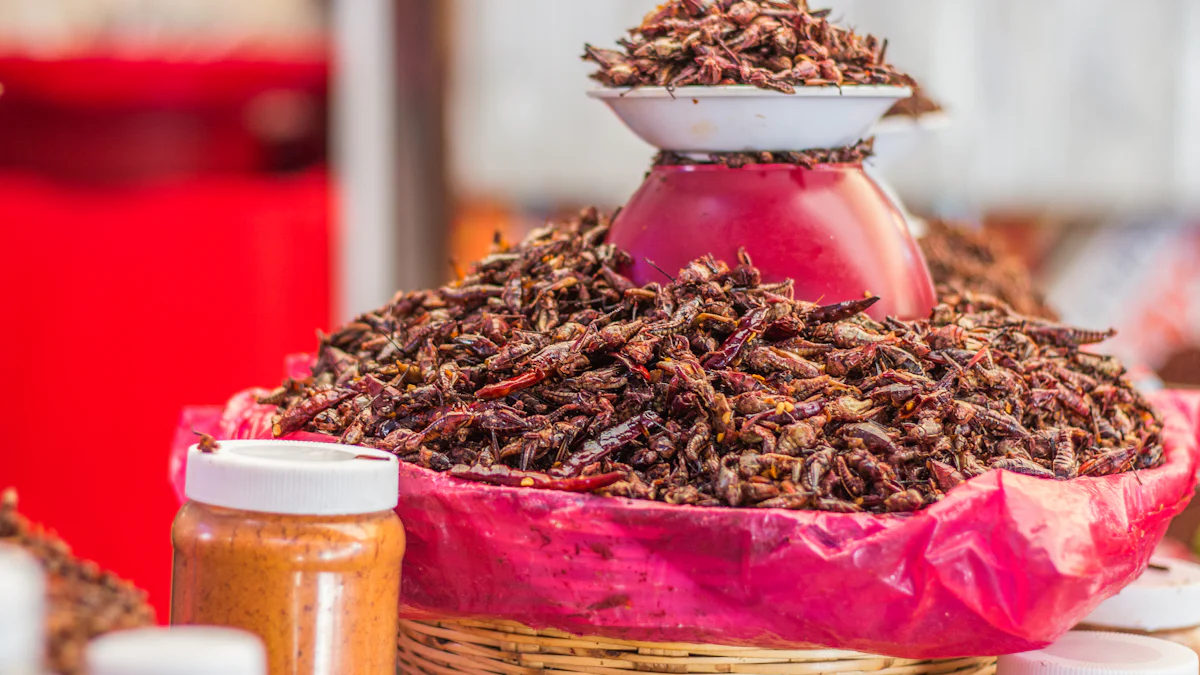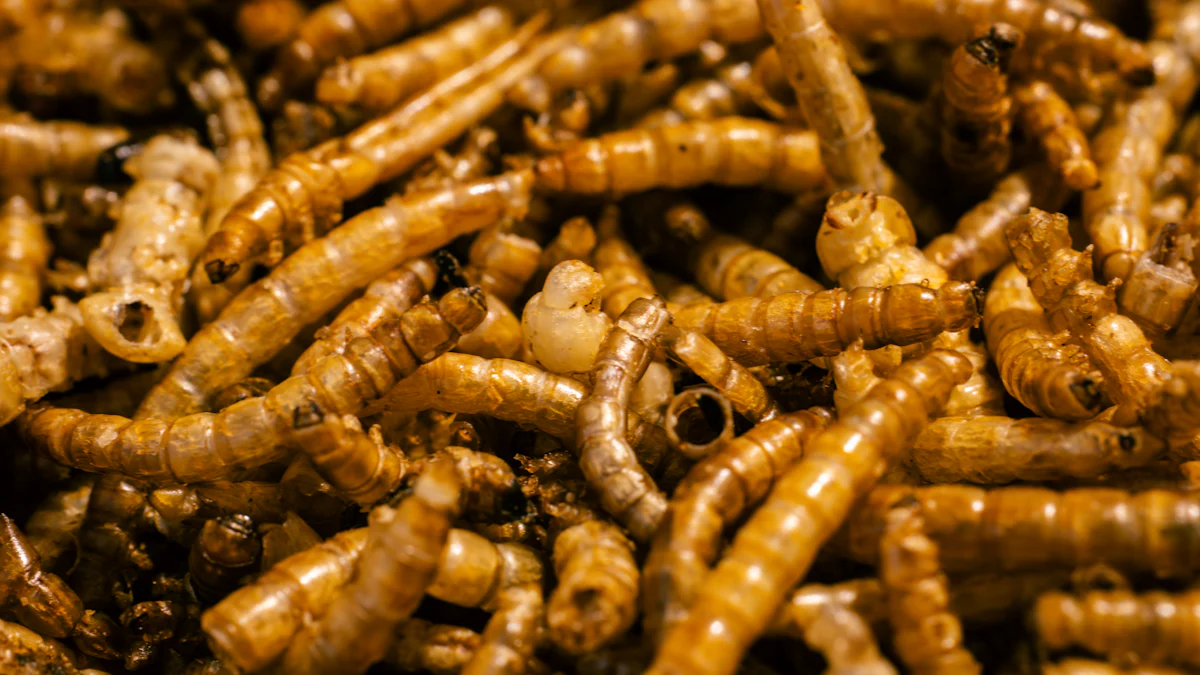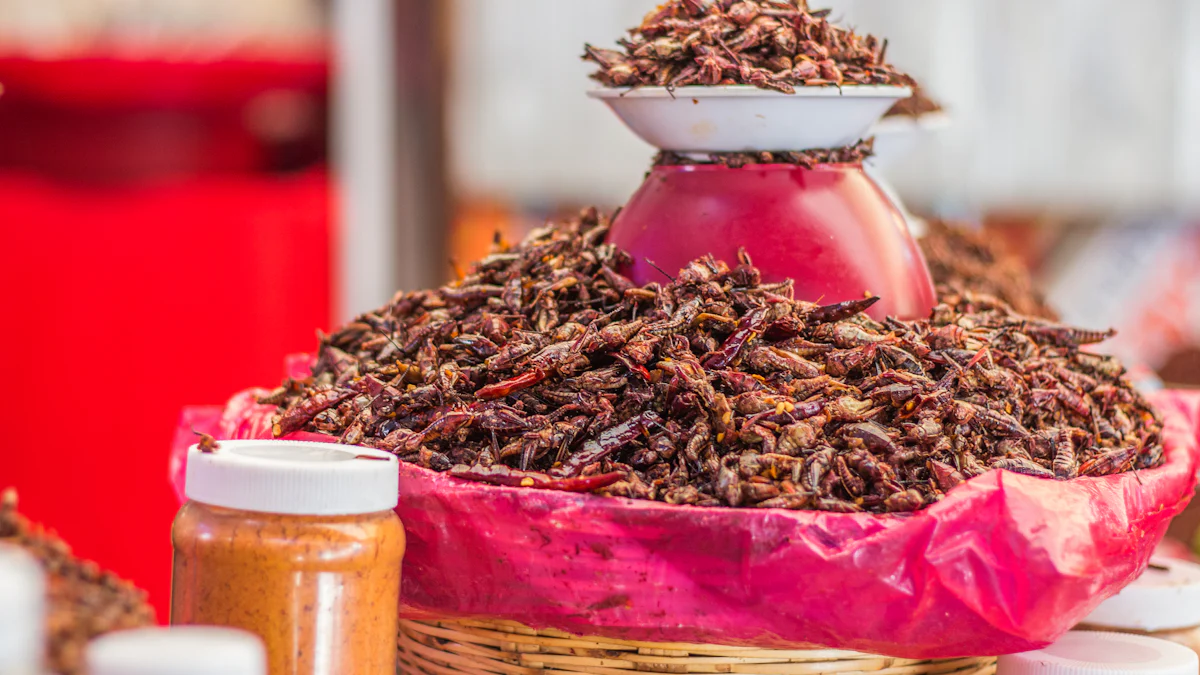
Dried mealworms for humans are the dehydrated larvae of the darkling beetle, packed with nutrients that support your health. They’re rich in protein, calcium, and magnesium, surpassing traditional protein sources like eggs or beef. Plus, they’re safe to eat! The European Food Safety Authority (EFSA) has confirmed their safety as a novel food product for humans.
Key Takeaways
- Dried mealworms are full of nutrients and have 53% protein.
- Protein helps muscles grow and heal after activity or injury.
- They are safe to eat, approved by food safety experts.
- Adding them to your meals can be a healthy choice.
- Mealworms are eco-friendly and need less food to grow.
- They also create fewer harmful gases than regular farm animals.
What Are Dried Mealworms for Humans?
Origin and How They Are Made
Dried mealworms for humans come from the larvae of the darkling beetle. These tiny creatures have been a part of diets in many cultures for centuries. Today, they’re gaining popularity as a sustainable and nutritious food source. But how do they go from larvae to the dried snack on your plate? The process is simple and ensures quality.
First, mealworms are carefully raised in controlled environments. Once they reach the right size, they’re blanched. This step reduces microbial contamination and stops enzymatic activity, keeping them fresh longer. After blanching, they’re dehydrated. A common method involves placing them in a dehydrator until they turn golden brown. Some people like to lightly coat them with olive oil and sprinkle a pinch of salt before eating them warm. Drying not only improves their texture and color but also enhances their microbiological quality and shelf life.
Why They Are Safe to Eat
You might wonder if dried mealworms for humans are safe. The answer is yes! The European Food Safety Authority (EFSA) has confirmed their safety as a novel food product. Their scientific opinion highlights that dried yellow mealworms are safe when prepared and stored properly. The EFSA’s assessment found no safety concerns, provided the mealworms meet specific standards during their shelf life. They also evaluated frozen and freeze-dried mealworms and found them safe for general consumption. However, if you have specific allergies, it’s best to consult a doctor first.
Dried mealworms are packed with protein, fat, and fiber, making them a healthy and safe addition to your diet.
Nutritional Value of Dried Mealworms

Protein and Muscle Support
If you’re looking for a protein-packed food, dried mealworms for humans are an excellent choice. They contain an impressive 53% protein, which is comparable to chicken and even higher than beef. This makes them a fantastic option for building and repairing muscles. Here’s a quick comparison:
| Food Source | Protein Content (%) |
|---|---|
| Dried Mealworms | 53 |
| Chicken | Similar |
| Beef | Higher |
Protein is essential for your body. It helps maintain muscle mass, supports tissue repair, and keeps you feeling full longer. Whether you’re an athlete or just want to stay healthy, mealworms can be a great addition to your diet.
Healthy Fats and Omega-3s
Dried mealworms are rich in healthy fats, especially unsaturated fatty acids like omega-6 and omega-9. These fats are good for your heart and overall health. However, their omega-3 content is relatively low compared to fish or flaxseeds. If you’re aiming to boost your omega-3 intake, you might want to pair mealworms with other sources like salmon or walnuts. Even so, the fats in mealworms provide energy and help your body absorb vitamins.
Vitamins, Minerals, and Fiber
Mealworms are tiny but mighty when it comes to nutrients. They are packed with essential vitamins like B2, B5, and B12, which help your body fight infections and stay energized. They also contain vitamin C and E, which support your immune system and skin health. Here’s a breakdown of their mineral content:
| Nutrient | Dried Mealworms | Comparison to Other Foods |
|---|---|---|
| Potassium | 10x more than eggs | Higher than pork, beef, milk |
| Calcium | 3x more than eggs | 23x more than pork and beef |
| Magnesium | 21x more than eggs | Higher than pork, beef, lamb |
| Iron | Higher than eggs | Higher than pork, beef, lamb |
| Copper | Higher than eggs | Higher than pork, beef, lamb |
| Zinc | Higher than eggs | Higher than pork, beef, lamb |
These minerals are vital for bone health, oxygen transport, and enzyme production. Plus, mealworms contain fiber, which aids digestion and keeps your gut healthy. With so many nutrients in one small package, it’s no wonder they’re gaining popularity as a superfood.
Mealworms are safe for human consumption. EFSA’s latest batch of scientific opinions on novel food applications includes a significant first – a safety assessment of a proposed insect-derived food product: dried yellow mealworm.
Health Benefits of Dried Mealworms for Humans
Boosting Energy and Metabolism
Do you ever feel like you need an energy boost to get through the day? Dried mealworms for humans can help with that! They’re packed with protein, healthy fats, and essential vitamins like B12, which play a key role in energy production. Protein helps fuel your muscles, while fats provide a steady source of energy. Plus, the B vitamins in mealworms support your metabolism, helping your body convert food into energy more efficiently. Whether you’re hitting the gym or just tackling a busy day, mealworms can give you the stamina you need.
Supporting Heart Health
Your heart works hard every day, so why not give it some extra love? Mealworms contain healthy unsaturated fats, including omega-6 and omega-9 fatty acids, which are known to support heart health. These fats can help lower bad cholesterol levels and improve overall cardiovascular function. Mealworms also provide magnesium and potassium, two minerals that help regulate blood pressure and keep your heart beating strong. Adding them to your diet is a simple way to take care of your heart while enjoying a tasty and nutritious snack.
Environmental and Sustainability Advantages
If you care about the planet, mealworms are a fantastic choice. They’re one of the most sustainable protein sources available. Compared to traditional livestock like chickens, mealworms require much less feed—only 3.61 kg of feed for the same amount of edible mass, while broilers need 4.91 kg. They also have a smaller environmental footprint. Mealworms produce significantly fewer terrestrial acidifying emissions, like ammonia, which means less harm to the environment. Plus, they thrive on by-products like wheat bran, reducing the need for additional resources. Choosing mealworms isn’t just good for you—it’s good for the Earth too!
Mealworms are safe for human consumption. EFSA’s latest batch of scientific opinions on novel food applications includes a significant first – a safety assessment of a proposed insect-derived food product: dried yellow mealworm.
How to Consume Dried Mealworms

Cooking Methods (Roasting, Frying, Baking)
Cooking dried mealworms is simple and fun! You can try different methods to suit your taste. Roasting is one of the easiest ways. Just spread them on a baking sheet, sprinkle some spices, and roast them in the oven until they’re crispy. This method enhances their flavor and keeps their nutrients intact. Frying is another option if you prefer a crunchier texture. Toss them in a little oil and fry until golden brown. Keep in mind that frying can change their nutritional profile due to oil absorption. Baking is perfect for adding mealworms to bread or muffins. Mix them into your batter and bake as usual. Each method brings out unique flavors while preserving their health benefits.
Tip: Blanching mealworms before cooking reduces microbial contamination and ensures freshness.
Adding to Recipes (Smoothies, Salads, Snacks)
Dried mealworms for humans are incredibly versatile. You can add them to almost any dish! Blend them into your morning smoothie for an extra protein boost. Toss them into your salad for a crunchy topping. Feeling adventurous? Use them as a filling for tacos or mix them into stir-fry dishes. They also make great snacks. Combine them with nuts and dried fruits for a homemade trail mix. For a sweet treat, bake them into protein bars with oats and nut butter. These creative ideas make it easy to include mealworms in your meals.
Tips for First-Time Consumers
Trying mealworms for the first time? Start small. Sprinkle a few roasted mealworms on your salad or mix them into a smoothie. Their nutty flavor pairs well with many dishes. If you’re hesitant, try them in recipes where they blend in, like muffins or protein bars. Always ensure they’re cooked properly to enjoy their best taste and texture. Remember, mealworms are safe for human consumption. EFSA’s scientific opinion confirms that dried yellow mealworms meet safety standards when prepared and stored correctly. So, take the leap and enjoy this nutritious superfood!
Dried mealworms for humans offer incredible benefits for your health and the planet. They’re packed with protein, healthy fats, and essential nutrients like potassium, calcium, and magnesium. These tiny powerhouses also contain more trace elements, like iron and zinc, than traditional proteins. Plus, they’re versatile—you can roast, bake, or toss them into your favorite recipes.
Choosing mealworms supports sustainability too. They produce fewer greenhouse gases, use less water, and require minimal space compared to conventional protein sources. Mealworms are safe for human consumption. EFSA’s latest batch of scientific opinions on novel food applications includes a significant first – a safety assessment of a proposed insect-derived food product: dried yellow mealworm. Why not give them a try and enjoy a nutritious, eco-friendly superfood?
FAQ
Are dried mealworms safe for humans to eat?
Yes, they are! The European Food Safety Authority (EFSA) confirms dried yellow mealworms meet safety standards when prepared and stored properly. Always check for allergies before trying them.
What do dried mealworms taste like?
They have a mild, nutty flavor. Some say they taste like roasted seeds or nuts. Their taste blends well with both savory and sweet dishes.
How should I store dried mealworms?
Keep them in an airtight container in a cool, dry place. Proper storage ensures freshness and maintains their nutritional value for longer.


